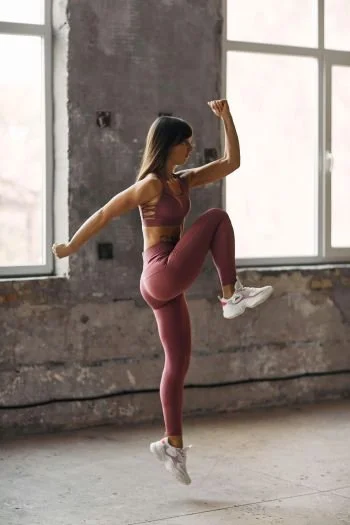Yoga builds strength, flexibility, balance, and cardiovascular stamina while training breath control and body awareness. Used consistently, a short yoga-focused practice can complement running, lifting, or everyday movement by targeting mobility, core stability, and muscular endurance without high impact.
Quick warm-up (5 minutes)
Cat–Cow: 6–8 slow cycles to mobilize the spine.
Dynamic low lunge with arm reaches: 6 each side to open hips and shoulders.
Sun salutation A (2 rounds) to raise heart rate and link breath with movement.
Pose 1 — Chair Pose (Utkatasana)
How to: Stand with feet hip-width, bend knees and sink hips as if sitting, lift arms overhead, draw ribs in, weight in heels.
Fitness benefits: Builds quad and glute strength, challenges core stability, improves posture and muscular endurance.
Breath and timing: Inhale to lengthen; exhale to sink. Hold for 30–60 seconds or 5–8 breaths for strength sets.
Modifications and progressions:
Easier: Keep hands at heart and sit less deeply.
Harder: Pulse slightly up and down or lift heels for single-leg chair pulses.
Cue: Keep knees tracking over toes, tailbone tucked slightly, shoulder blades grounded.
Pose 2 — Warrior II (Virabhadrasana II)
How to: From a wide stance, turn front foot forward and back foot slightly in; bend the front knee over ankle, extend arms parallel to the floor, gaze over front hand.
Fitness benefits: Strengthens legs, opens hips, builds lateral stability and stamina, engages shoulders and upper back.
Breath and timing: Breathe steadily; hold 30–45 seconds each side or do 3 rounds of 20–30-second holds for endurance.
Modifications and progressions:
Easier: Shorten the stance and reduce knee bend.
Harder: Transition into high lunge pulses or add light hand weights to challenge shoulders.
Cue: Front knee stacked over ankle, back leg active and straight, torso upright.
Short sequence to combine both (15–20 minutes)
Warm-up sequence above (5 minutes).
Chair Pose hold: 45 seconds, release, repeat twice with 30 seconds rest.
Sun salutation A or two dynamic lunges to reset.
Warrior II flow: 3 rounds per side — step into Warrior II, hold 30 seconds, straighten to standing, repeat.
Finish with 5 minutes of core-focused moves: 2 rounds of 30-second plank, 30-second side planks each side.
Cool-down: Seated forward fold (1–2 minutes), supine twist (30 seconds each side), and Savasana (3–5 minutes).
Programming tips and safety
Frequency: 3–5 short sessions per week supports strength and mobility gains.
Combine with other training: Use yoga on active recovery days or as a warm-up before strength sessions.
Listen to your body: Avoid forcing depth into joints; prioritize alignment over appearance.
Injuries: Modify or skip poses that aggravate pain and consult a professional when necessary.
A focused yoga practice that blends Chair Pose and Warrior II trains functional strength, endurance, and balance without heavy equipment. Keep sessions brief and consistent, and adjust intensity by changing hold durations, repetitions, or adding small progressions to continue improving fitness.












